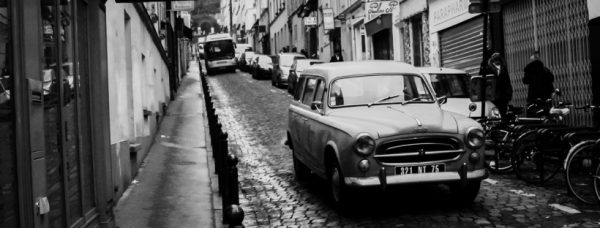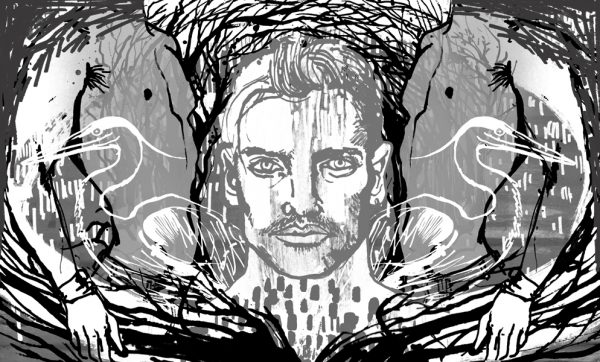IT IS 1 JUNE 2015 AND I AM STANDING OUTSIDE no. 11 rue Servandoni in Paris’s sixth arrondissement. I have lived in this city, on and off, for over ten years. I’ve walked in and through the Jardin de Luxembourg many times, likewise the loop around Place Saint-Sulpice (I can see now how the rue Servandoni serves as a corridor between the two). But it so happens, I realise, that I’ve never walked down this particular street before. Now that I’m here, I’m wondering why it has never, not once, occurred to me to seek this building out: the building where Roland Barthes lived for twenty years, from 1960 to 1980, in an apartment on the sixth floor.
I’m standing outside no. 11, the street is empty, the sun is warm and I’m trying hard to feel something of the curiosity – what Barthes would call a biographical curiosity, of the kind that would unexpectedly fire him up late in life – that might have prompted me to do so.
I try imagining a body. For instance, leaning some of its weight against one of the heavy double doors, pushing it open, stepping inside and climbing the stairs marked B.
Or a forefinger punching out the building code: once, twice, several times a day, over the space of twenty years.
But the thing is: I’m finding it difficult. Much easier to summon are the characters that Alexandre Dumas has live next door. Here is D’Artagnan, the new Musketeer, defending Constance with clashing swords; here are the two of them creeping along this very street at dusk; here are the neighbours who close their shutters and all go to bed early.
It’s not that I am uncurious about the life Barthes lived upstairs. I know that’s not it, because, really, I’m fascinated.
It’s more that what I am most urgently interested in – what I came here today, hot and self-conscious on the bus, especially to consider – is my own pavement position.
It is 1 December 1976 and Barthes is looking out of the window. He sees a woman walking with her child on the street below.
In his notes he writes her like this: she is holding the kid by the hand, walking and pushing the empty buggy out ahead.
Buggy, pushchair: these were my original British-English translations of poussette.
But the words mean different things to an American reader, so I learn. Because of this, they are rejected by the copy-editor in favour of stroller.
The woman is walking steadily, purposively, at her own pace. The child, meanwhile, is being pulled along. Or dragged. She is dragging him, notes Barthes: tugging at his arm, forcing him to run to keep up. Like an animal. Or more hyperbolically still: like one of Sade’s victims being whipped. Here is the woman walking, steadily and purposively at her own pace, seemingly unaware that her child’s walking rhythm is different. Barthes is – what? Dismayed, indignant, outraged. He writes, with emphasis: And she’s his mother!
I have often thought of this woman. More specifically, I’ve often thought of her as I’ve walked with my own children, in a nearby but quite different neighbourhood of Paris, with the work of translating Barthes’s sentences agitating at my brain. Walking and doing exactly as he describes: tugging at my sons, pushing an empty buggy, striding (not strolling) ahead, failing – sometimes even making a point of refusing – to calibrate my pace with theirs. Clearly, or so it has always seemed to me, there’s something excessive to the point of comical about Barthes’s instant outrage. Maybe they were late? Maybe she just wanted to get home? Maybe she was thinking about something else? Maybe she was tired?
Still, I can see his point. For Barthes, briefly caught by this dynamic of mother and child are the central concerns of the lecture course he was preparing at the time. And I register how the point is being made. I know it’s important that the scene should have been glimpsed from a window, appearing bright and striking against the background of other, more or less absorbing, daily activities. In a lecture course where the ethical is made explicitly a matter of everyday social interactions and relations, Barthes would use the walking woman to describe how power can appear as rhythmic incompatibility. In other words, how power gets exercised and felt in the imposition of one rhythm on another.
The pavement directly outside Barthes’s apartment building is reasonably wide. Wide enough for a woman, empty buggy and child. But it narrows to something more like a ledge as the street inclines towards the park. Sooner or later, she would have had to walk in the road, negotiating the curb and the parked cars with her empty buggy and her small son. If this, indeed, is where he saw her. The sixth floor has a deep balcony. Would Barthes have had a clear view of the street below? Probably not. Perhaps he was looking out of his office at the College de France? Did he have an office there? Did it have a window? I could find out. I could ask his biographers, his editors, those who knew him. I could stand on the rue Saint-Jacques instead, conscientious in my investigation of the bad mother (as she’s described in the preface to the French edition).
I don’t, though. Because what concerns me is exactly this: the not-knowing, the distance. I have never been inside, with Barthes, as he drafted his lecture courses for the first time. I was born two years after the first course was conceived. But I have been with the written and recorded Barthes – the notes and the voice – in the thoroughly mediated sense of being-with that is produced in and by the action of writing his sentences and bits of sentences again.




